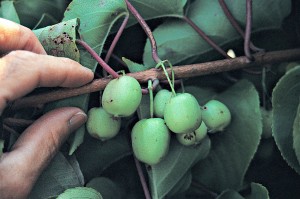Grow Hardy Kiwifruits for Beauty and Good Eating
Posted in Exhibitions, Gardening Tips, The Edible Garden on August 27 2009, by Plant Talk
 |
Lee Reich, Ph.D., , who has worked in soil and plant research for the USDA and Cornell University, is a garden writer and consultant. He will be presenting at The Edible Garden on September 13. |
 It’s August as I write, and I’ve just picked a fruit that’s as uncommon as it is delectable—and it’s borne on a most beautiful plant. The fruit is hardy kiwifruit, which is in many ways similar to the fuzzy kiwifruits of our markets. Those fuzzies are cold tender, though, while hardy kiwifruits are, well, very cold hardy. Fruits of either species have lime-green flesh with tiny, black seeds and, when sliced crosswise, exhibit the lighter-colored rays that are the source of the generic name Actinidia (actin is Latin for “ray”). Their flavors are similar, except that hardy kiwifruits are a whit sweeter and more aromatic. The small, cold-hardy cousins of the fuzzy kiwifruits also are grape-size and have a smooth skin that’s edible, so you just pop the whole fruit into your mouth and enjoy.
It’s August as I write, and I’ve just picked a fruit that’s as uncommon as it is delectable—and it’s borne on a most beautiful plant. The fruit is hardy kiwifruit, which is in many ways similar to the fuzzy kiwifruits of our markets. Those fuzzies are cold tender, though, while hardy kiwifruits are, well, very cold hardy. Fruits of either species have lime-green flesh with tiny, black seeds and, when sliced crosswise, exhibit the lighter-colored rays that are the source of the generic name Actinidia (actin is Latin for “ray”). Their flavors are similar, except that hardy kiwifruits are a whit sweeter and more aromatic. The small, cold-hardy cousins of the fuzzy kiwifruits also are grape-size and have a smooth skin that’s edible, so you just pop the whole fruit into your mouth and enjoy.
Hardy kiwifruits were introduced into this country from western Asia over a hundred years ago not for their delectable fruit but for their beauty. The vines—originally distributed under the common name bower actinidias—can still be found growing as such on the grounds of many botanical gardens and old estates. (At NYBG, look for hardy kiwifruit vines in the Everett Children’s Adventure Garden.) I wonder how many visitors passed beside arbors or under pergolas over which the vines clambered, admiring the beauty of the plants but unaware of the fruit that hides so well beneath the foliage.
Things changed about 30 years ago when fruit enthusiasts started to become aware of those delectable treasures and began planting the vines for fruit harvest. (Both male and female plants are needed for fruiting.) Two species are prominent for their fruits. A. arguta is the more vigorous of the two. In the wild, it will often climb 100 feet high into trees, so needs adequate support and space—about 200 square feet per plant—in a garden. The apple-green leaves have red stalks and maintain their fresh, spring look throughout the growing season. With age, the trunks become ornamental with their decorative twists and bark that peels in long, gray strips. The fruits ripen from mid-September onward.
